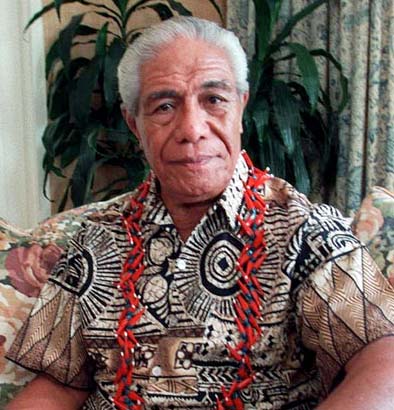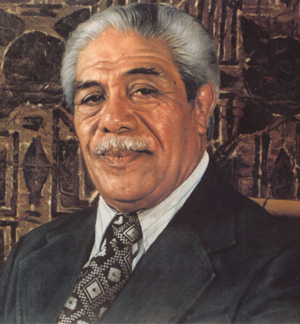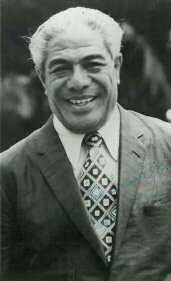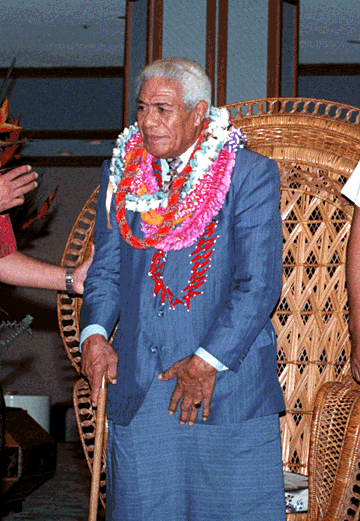<Back to Index>
- Physician Manuel Dias de Abreu, 1894
- Painter Aristarkh Lentulov, 1882
- Malietoa of Samoa Tanumafili II, 1913
PAGE SPONSOR


Malietoa Tanumafili II, GCMG, CBE, (4 January 1913 – 11 May 2007) (also called Susuga) was the Malietoa, the title of one of Samoa's four paramount chiefs, and the head of state, or O le Ao o le Malo, a position that he held for life, of Samoa from 1962 to 2007. He was co-chief of state in 1962 and became the sole head of state on 15 April 1963. At the time of his death, he was the oldest national leader in the world.
He was born in 1913 as the son and third child of his parents, Malietoa Tanumafili I and Momoe Lupeuluiva Meleisea. He became the Mālietoa in 1940 following his father's death in 1939.
Tanumafili was educated at the government run Leififi School in Samoa. He went on to enroll at St. Stephen's College and Wesley College in Pukekohe, both of which are in New Zealand. Malietoa was an active athlete during his younger years. His favorite sports included boxing, rugby and cricket. Malietoa's interest in sports continued throughout his life and he was an avid golfer well into his 90s. He could often be seen driving his golf cart around Samoa.
His wife, Lili Tunu, died in 1986. Tanumafili had nine surviving children at the time of his death in 2007: Su'a Vainuupo, Faamausili Moli, Papali'itele Titiuatoa, Papali'itele Ioane, Papali'itele Douglas (sons) and Seiuli Tutai, Lola Tosi and Momoe (daughters). One child died in infancy, while his sons, Papaliitele Eti, died in 2005, Papali'itele Molioo Laupepa, died in 1985.
Malietoa Tanumafili II was a follower of the Bahá'í Faith. He was the second royal (after Queen Marie of Romania) to be a member of that religion. The Bahá'í House of Worship in Tiapapata, eight kilometers from the country's capital of Apia, was dedicated by him in 1984. Tanumafili officially inherited the royal title of Malietoa in 1940, following the 1939 death of his father,Malietoa Tanumafili I, though
some media reports claim that he received the title of Malietoa in
1939. Soon after becoming Malietoa, he was appointed to serve as a
special adviser, also called Fautua, to the New Zealand administration and governor of Samoa, known as the New Zealand Trusteeship of Samoa, until independence in 1962. Upon Samoa's independence in 1962, Malietoa Tanumafili II became joint O le Ao o le Malo, or head of state, with Tupua Tamasese Mea'ole. Tanumafili and Mea'ole would rule jointly as head of state for just 16 months. When
Mea'ole died in 1963, Tanumafili became the sole Samoan head of state,
a post he held for life until his death in 2007. He is often credited
for providing much of the stability that Samoa has enjoyed post
independence. Malietoa traveled extensively during his reign as the Samoan head of state (O le Ao o le Malo). He traveled to the People's Republic of China for an official state visit in 1976. Additionally, during his reign he also visited Australia, Fiji, Hawai'i, Japan, New Zealand, South Korea, Tonga, the United Kingdom and the former West Germany. Malietoa Tanumafili was among the foreign dignitaries who attended the funeral of Japanese Emperor Showa in 1989. Malietoa
Tanumafili II was described as the last survivor of a generation of
important Pacific leaders who guided their countries and peoples from colonialism to independence. His
death was the latest in a string of recent, high profile passings of
members of this Pacific generation of leaders, which included the late
Fijian president, Ratu Sir Kamisese Mara, the King of Tonga, Taufa'ahau Tupou IV, and New Zealand's Maori Queen, Dame Te Atairangikaahu.
Malietoa Tanumafili II died at 6:45 P.M. on Friday 11 May 2007, at the
Tupua Tamasese Meaole National Hospital at Moto'otua in Apia, Samoa. He was being treated as a patient for pneumonia at the hospital for approximately a week. The cause of his death was from a heart attack. His death was announced by Samoan Secretary of State Vaasatia Poloma Komiti on SBC TV1. "It is with deepest regret that we inform you of the passing of our Head of State Malietoa Tanumafili II." Malietoa Tanumafili II was the world's third longest reigning living monarch at the time of his death in May 2007 after Thailand's King Bhumibol Adulyadej, who has reigned since 1946 and Britain's Queen Elizabeth II, who has reigned since 1952.
Samoa entered a state of official mourning from the time of the Malietoa's death until his official funeral. All
Samoan flags were
lowered to half mast in his honour and remembrance. According to
tradition, thousands of Samoans were expected to wear white and black
as a sign of respect for the Malietoa from 15 May until his state
funeral on May 18. The government of Samoa encouraged traditional
Samoan dress for the funeral. Samoans were requested specifically to
wear "a black lavalava or sulu and a white top with traditional elei patterns." Samoans were also asked to include the teuila flower, the national flower of Samoa, with their mourning attire. Malietoa Tanumafili II's body was taken from a private funeral home (Ligaliga Funeral) to his residence at Fa'ato'ialemanu on
16 May, which marked the beginning of his funeral services. Hundreds of
the Malietoa's close and extended relatives, including his children,
attended a special private family service that night. The
State funeral was a rare occasion when ancient rituals and exchanges
were made to the Sa Malietoa (the national political 'family' or clan
from which the Malietoa title belongs). Traditional cultural
presentations (or Si'i Fa'atupu) from other districts and clans from
within Samoa were made and ancient funeral rites were performed. The
delegation (or auala) from Lufilufi, representing the TuiAtua, circled
the Maota of Malietoa at Faatoialemanu where the late Malietoa lay in
state, chanting the ancient funeral chants associated with the district
of Atua and its relationship with the district of Tuamasaga (where the
Malietoa is the paramount title). Traditional delegations representing
the Tongan Royal Family and the Fijian Great Council of Chiefs also
made cultural presentations to reflect the ancient genealogical ties
between Samoa and her southern neighbours Tonga and Fiji. The
major village of the Malietoa title, Malie, played a major role in
funeral ceremonies and exchanges. The 'aumaga (untitled men) of Malie,
called the Aumaga a Laauli, and the 'aumaga (untitled men) of
Falealili, called the Manu Samoa, provided hundreds of traditional
guards in and around the compounds where the Malietoa lay in state.
They also patrolled the roads around Faatoialemanu and provided
escorting duties whenever the body was moved. On the day of the funeral
the grounds of Tiafau Malae where the funeral was held were guarded by
300 men of the Aumaga a Laauli. Presiding over the body was the
Salelesi (the ancient 'dog' of the Malietoa, from the village of
Salelesi (District of Atua). His role is to guard the body and escort
it into the tomb. All villages in the District of Tuamasaga and other
villages connected to the Malietoa title cut palm leaves and branches
of hundreds of coconut trees and laid them by the side of main roads in
an ancient mark of mourning for the death of a paramount chief. His body was then moved to the Samoan Parliament to lie in state on 17 May. His funeral was held on 18 May in Apia.
Queen Elizabeth II visited Samoa for a single day in 1977 as part of her visit to the South Pacific on board the Royal Yacht Britannia. While in Samoa, Elizabeth presented Malietoa with the Collar Badge and Star of a Knight Grand Cross of the Order of St Michael and St George. Also bestowed on Malietoa was the title of Honorary Commander of the Order of the British Empire during his life.

